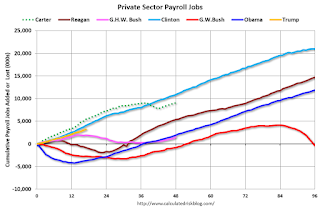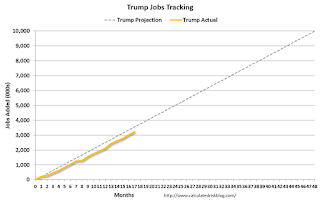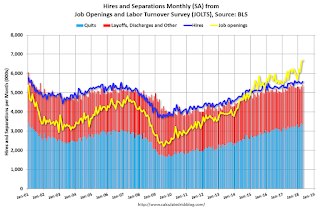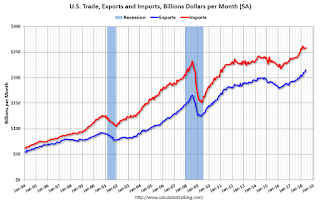by Calculated Risk on 7/09/2018 09:17:00 AM
Monday, July 09, 2018
Black Knight Mortgage Monitor for May
Black Knight released their Mortgage Monitor report for May today. According to Black Knight, 3.64% of mortgages were delinquent in May, down from 3.79% in May 2017. Black Knight also reported that 0.59% of mortgages were in the foreclosure process, down from 0.83% a year ago.
This gives a total of 4.23% delinquent or in foreclosure.
Press Release: Black Knight’s May 2018 Mortgage Monitor
Today, the Data & Analytics division of Black Knight, Inc.released its latest Mortgage Monitor Report, based on data as of the end of May 2018. This month, the company looks again at tappable equity, or the share of equity available for homeowners with mortgages to borrow against before reaching a maximum total combined loan-to-value (LTV) ratio of 80 percent. Despite the record-setting growth in such equity seen in the first quarter of 2018, homeowners are withdrawing equity at a lower rate than in the past. As Ben Graboske, executive vice president of Black Knight’s Data & Analytics division explained, although total equity withdrawn by dollar amount has increased slightly since the same time last year, the rate of growth pales in comparison to that of tappable equity.
“In Q1 2018, homeowners with mortgages withdrew $63 billion in equity via cash-out refinances or HELOCs,” said Graboske. “That represents a slight one percent increase from the same time last year, despite the fact that the amount of equity available for homeowners to borrow against increased by 16 percent over the same time period. Collectively, American homeowners now have $5.8 trillion in tappable equity available, yet only 1.17 percent of that total was withdrawn in the first quarter of the year. That’s the lowest quarterly share in four years, and the second lowest since the housing recovery began six years ago. Somewhat surprisingly, even though rising first-lien interest rates normally produce an increase in HELOC lending, the volume of equity withdrawn via lines of credit dropped to a two-year low as well.
“One driving factor in the decline of HELOC equity utilization is likely the increasing spread between first-lien mortgage interest rates – which are tied most closely to 10-year Treasury yields – and those of HELOCs – which are more closely tied to the federal funds rate. As of late last year, the difference between a HELOC rate and a first-lien rate had widened to 1.5 percent, the widest spread we’ve seen since we began comparing the two rates 10 years ago. The distance between the two has closed somewhat in Q2 as 30-year mortgage rates have been on the rise, which does suggest the market remains ripe for relatively low-risk HELOC lending expansion. Still, increasing costs in the form of higher interest rates do appear to have impacted homeowners’ borrowing decisions in Q1 2018. We should also remember that the Federal Reserve raised its target interest rate again at its June meeting, which will likely further increase the standard interest rate on HELOCs in Q3 2018. Black Knight will continue to monitor the situation moving forward.”
The data also showed that tappable equity increased by more than $380 billion in Q1 2018, the largest single-quarter growth since Black Knight began tracking the metric in 2005. On an annual basis, total tappable equity increased $820 billion, a 16.5 percent increase over the prior 12 months. The $5.8 trillion in total available tappable equity is 16 percent higher than the peak seen during the pre-recession peak in 2006. Nearly 80 percent of the nation’s tappable equity is held by homeowners with first-lien interest rates at or below 4.5 percent, with 60 percent of the total being held by those with current rates below 4.0 percent. The average mortgage holder gained $14,700 in tappable equity over the past year and has $113,900 in total available equity to borrow against.
emphasis added
 Click on graph for larger image.
Click on graph for larger image.This graph from Black Knight shows the number of active foreclosure since 2000.
From Black Knight:
• The number of active foreclosures has declined from 2.3M at the peak in December 2010 to just 303k remaining today
• At the current rate of improvement (-29% Y/Y), the national foreclosure rate is on pace to ‘normalize’ (to the 2000-2005 average) within the next three months
• The number of outstanding foreclosures is on track to normalize in September 2018
• Given the various factors noted on the previous page, we may see foreclosure volumes dip even further
• Holding today's rate of improvement steady, both foreclosure rates and active foreclosure inventory would fall to the lowest level this century within the next 18 months

The second graph shows Black Knight's estimate of "Tappable Equity":
• Tappable equity increased by $820B (+16.5%) over the past 12 monthsThere is much more in the mortgage monitor.
• A total of $5.8T in tappable equity now held by U.S. homeowners with mortgages represents the highest volume ever recorded, and 16% above the mid-2006 peak
• Tappable equity grew by >$380B (+7%) in Q1 2018 alone, marking the largest single quarter growth volume of lendable equity since Black Knight began tracking it in 2005
...
• A large driver has been rising home prices, which rose + 2.5% in just the first 3 months of 2018, about +$6,900 for the median-priced home
• Additionally, declining current combined LTVs (CLTV) – now 52% on average, the lowest ever recorded by Black Knight – mean that the majority of home price gains are immediately eligible to be tapped
Oil Rigs: "A rebound after last week's fall"
by Calculated Risk on 7/09/2018 08:56:00 AM
A few comments from Steven Kopits of Princeton Energy Advisors LLC on July 6, 2018:
• Rig counts recovered after last week’s lousy numbers
• Total oil rigs are up, +5 to 863
• Horizontal oil rigs rebounded, +6 to 771
...
• The big movers this week were the Cana Woodford, -6; and Other US, +7. Expect some reversal of these numbers next week.
 Click on graph for larger image.
Click on graph for larger image.CR note: This graph shows the US horizontal rig count by basin.
Graph and comments Courtesy of Steven Kopits of Princeton Energy Advisors LLC.
Sunday, July 08, 2018
Sunday Night Futures
by Calculated Risk on 7/08/2018 06:39:00 PM
Weekend:
• Schedule for Week of July 8, 2018
Monday:
• At 3:00 PM ET, Consumer Credit from the Federal Reserve. The consensus is for consumer credit to increase $12.4 billion in May.
From CNBC: Pre-Market Data and Bloomberg futures: S&P 500 are up 4, and DOW futures are up 45 (fair value).
Oil prices were mixed over the last week with WTI futures at $73.96 per barrel and Brent at $77.29 per barrel. A year ago, WTI was at $44, and Brent was at $47 - so oil prices are up about 65% year-over-year.
Here is a graph from Gasbuddy.com for nationwide gasoline prices. Nationally prices are at $2.86 per gallon. A year ago prices were at $2.26 per gallon - so gasoline prices are up 60 cents per gallon year-over-year.
Public and Private Sector Payroll Jobs During Presidential Terms
by Calculated Risk on 7/08/2018 11:39:00 AM
By request, here is another update of tracking employment during Presidential terms. We frequently use Presidential terms as time markers - we could use Speaker of the House, Fed Chair, or any other marker.
NOTE: Several readers have asked if I could add a lag to these graphs (obviously a new President has zero impact on employment for the month they are elected). But that would open a debate on the proper length of the lag, so I'll just stick to the beginning of each term.
Important: There are many differences between these periods. Overall employment was smaller in the '80s, however the participation rate was increasing in the '80s (younger population and women joining the labor force), and the participation rate is generally declining now. But these graphs give an overview of employment changes.
The first graph shows the change in private sector payroll jobs from when each president took office until the end of their term(s). Presidents Carter and George H.W. Bush only served one term.
Mr. G.W. Bush (red) took office following the bursting of the stock market bubble, and left during the bursting of the housing bubble. Mr. Obama (dark blue) took office during the financial crisis and great recession. There was also a significant recession in the early '80s right after Mr. Reagan (dark red) took office.
There was a recession towards the end of President G.H.W. Bush (light purple) term, and Mr Clinton (light blue) served for eight years without a recession.

The first graph is for private employment only.
Mr. Trump is in Orange (just 17 months).
The employment recovery during Mr. G.W. Bush's (red) first term was sluggish, and private employment was down 804,000 jobs at the end of his first term. At the end of Mr. Bush's second term, private employment was collapsing, and there were net 391,000 private sector jobs lost during Mr. Bush's two terms.
Private sector employment increased by 20,964,000 under President Clinton (light blue), by 14,717,000 under President Reagan (dark red), 9,041,000 under President Carter (dashed green), 1,509,000 under President G.H.W. Bush (light purple), and 11,907,000 under President Obama (dark blue).
During the first 17 months of Mr. Trump's term, the economy has added 3,188,000 private sector jobs.

The public sector grew during Mr. Carter's term (up 1,304,000), during Mr. Reagan's terms (up 1,414,000), during Mr. G.H.W. Bush's term (up 1,127,000), during Mr. Clinton's terms (up 1,934,000), and during Mr. G.W. Bush's terms (up 1,744,000 jobs). However the public sector declined significantly while Mr. Obama was in office (down 266,000 jobs).
During the first 17 months of Mr. Trump's term, the economy has added 28,000 public sector jobs.

After 17 months of Mr. Trump's presidency, the economy has added 3,216,000 jobs, about 326,000 behind the projection.
Saturday, July 07, 2018
Schedule for Week of July 8, 2018
by Calculated Risk on 7/07/2018 08:11:00 AM
The key economic report this week is the June Consumer Price Index (CPI) on Thursday.
3:00 PM: Consumer Credit from the Federal Reserve. The consensus is for consumer credit to increase $12.4 billion in May.
6:00 AM: NFIB Small Business Optimism Index for June.
 10:00 AM ET: Job Openings and Labor Turnover Survey for May from the BLS.
10:00 AM ET: Job Openings and Labor Turnover Survey for May from the BLS. This graph shows job openings (yellow line), hires (purple), Layoff, Discharges and other (red column), and Quits (light blue column) from the JOLTS.
Job openings increased in April to 6.698 million from 6.633 million in March.
The number of job openings (yellow) were up 9.7% year-over-year, and Quits were up 9.1% year-over-year.
7:00 AM ET: The Mortgage Bankers Association (MBA) will release the results for the mortgage purchase applications index.
8:30 AM: The Producer Price Index for June from the BLS. The consensus is a 0.2% increase in PPI, and a 0.2% increase in core PPI.
8:30 AM: The initial weekly unemployment claims report will be released. The consensus is for 225 thousand initial claims, down from 231 thousand the previous week.
8:30 AM: The Consumer Price Index for June from the BLS. The consensus is for a 0.2% increase in CPI, and a 0.2% increase in core CPI.
10:00 AM: University of Michigan's Consumer sentiment index (Preliminary for July).
11:00 AM: Federal Reserve Monetary Policy Report to Congress
Friday, July 06, 2018
Q2 GDP Forecasts
by Calculated Risk on 7/06/2018 08:51:00 PM
From Merrill Lynch:
The [trade] data bumped up 2Q GDP tracking by a tenth to 3.8% qoq saar. [July 6 estimate].And from the Altanta Fed: GDPNow
emphasis added
The GDPNow model estimate for real GDP growth (seasonally adjusted annual rate) in the second quarter of 2018 is 3.8 percent on July 6, down from 4.1 percent on July 2. [July 6 estimate]From the NY Fed Nowcasting Report
The New York Fed Staff Nowcast stands at 2.8% for 2018:Q2 and 2.7% for 2018:Q3. [July 6 estimate]CR Note: These estimates suggest real annualized GDP in the 2.8% to 3.8% range in Q2.
AAR: Rail Carloads Up 2.0% YoY, Intermodal Up 6.3% YoY
by Calculated Risk on 7/06/2018 05:27:00 PM
From the Association of American Railroads (AAR) Rail Time Indicators. Graphs and excerpts reprinted with permission.
All things considered, it could be a lot worse for rail traffic. U.S. railroads originated 1,159,973 containers and trailers in June 2018, up 6.3% over June 2017. Average weekly intermodal volume in June 2018 was 289,993 units, easily the most for any month in history. U.S. railroads also originated 1,080,769 carloads in June 2018, up 2.0%, or 21,098 carloads, over June 2017.
…
Not all is well, though. For example, weekly average U.S. grain carloads in June 2018 were the most for June since 1995, but near-term rail grain movements, especially soybeans, are at risk because of the ongoing trade fights. The more tit-for-tat escalation there is, the more railroads could suffer.
 Click on graph for larger image.
Click on graph for larger image.This graph from the Rail Time Indicators report shows U.S. average weekly rail carloads (NSA). Light blue is 2018.
Rail carloads have been weak over the last decade due to the decline in coal shipments.
Total originated U.S. rail carloads in June 2018 were 1,080,769, up 2.0%, or 21,098 carloads, over June 2017. That’s the fourth straight year-over-year monthly increase, something that hasn’t happened since last June. Total carloads averaged 270,192 in June 2018, the most for June since 2015 and the most for any month since October 2015.
 The second graph is for intermodal traffic (using intermodal or shipping containers):
The second graph is for intermodal traffic (using intermodal or shipping containers):U.S. railroads originated 1,159,973 intermodal containers and trailers in June 2018, up 6.3%, or 68,689 units, over June 2017. Average weekly intermodal volume in June 2018 was 289,993 units, easily the most ever. (The old record was 279,853 in February 2018.) In fact, the four weeks comprising June 2018 were first, third, fourth, and fifth on the all-time weekly U.S. intermodal list.
Las Vegas Real Estate in June: Sales Down 4% YoY, Inventory down 11%
by Calculated Risk on 7/06/2018 03:05:00 PM
This is a key former distressed market to follow since Las Vegas saw the largest price decline, following the housing bubble, of any of the Case-Shiller composite 20 cities.
The Greater Las Vegas Association of Realtors reported Southern Nevada housing market looking a lot like the summer weather, GLVAR housing statistics for June 2018
A housing market report released today by the Greater Las Vegas Association of REALTORS® (GLVAR) looks a lot like the summer weather in Southern Nevada, with local home prices continuing to heat up from last year at this time while the housing supply stayed desert dry.1) Overall sales were down 4.0% year-over-year from 4,368 in June 2017 to 4,194 in June 2018.
...
The total number of existing local homes, condos and townhomes sold during June was 4,194. Compared to one year ago, June sales were down 8.9 percent for homes, but up 18.5 percent for condos and townhomes.
...
By the end of June, GLVAR reported 4,335 single-family homes listed for sale without any sort of offer. That’s down 16.2 percent from one year ago. For condos and townhomes, the 822 properties listed without offers in June represented a 28.6 percent increase from one year ago.
...
At the same time, the number of so-called distressed sales continues to decline. GLVAR reported that short sales and foreclosures combined accounted for 2.6 percent of all existing local home sales in June, down from 6.3 percent of all sales one year ago.
emphasis added
2) Active inventory (single-family and condos) is down from a year ago, from a total of 5,813 in June 2017 to 5,157 in June 2018. Note: Total inventory was down 11.3% year-over-year - a significant decline - but this was the smallest year-over-year decline in inventory since May 2016.
3) Fewer distressed sales.
Trade Deficit decreased to $43.1 Billion in May
by Calculated Risk on 7/06/2018 12:13:00 PM
From the Department of Commerce reported:
The U.S. Census Bureau and the U.S. Bureau of Economic Analysis announced today that the goods and services deficit was $43.1 billion in May, down $3.0 billion from $46.1 billion in April, revised. … May exports were $215.3 billion, $4.1 billion more than April exports. May imports were $258.4 billion, $1.1 billion more than April imports.
 Click on graph for larger image.
Click on graph for larger image.Both exports and imports increased in May.
Exports are 30% above the pre-recession peak and up 12% compared to May 2017; imports are 11% above the pre-recession peak, and up 8% compared to May 2017.
In general, trade has been picking up.
The second graph shows the U.S. trade deficit, with and without petroleum.
 The blue line is the total deficit, and the black line is the petroleum deficit, and the red line is the trade deficit ex-petroleum products.
The blue line is the total deficit, and the black line is the petroleum deficit, and the red line is the trade deficit ex-petroleum products.Oil imports averaged $58.37 in May, up from $54.00 in April, and up from $45.04 in May 2017.
The trade deficit with China increased to $33.2 billion in May, from $31.9 billion in May 2017.
Comments on June Employment Report
by Calculated Risk on 7/06/2018 09:59:00 AM
The headline jobs number at 213,000 for June was above consensus expectations of 190 thousand, and the previously two months were revised up by a combined 37 thousand. Overall this was a strong report.
Earlier: June Employment Report: 213,000 Jobs Added, 4.0% Unemployment Rate
In June, the year-over-year employment change was 2.374 million jobs. This is solid year-over-year growth.
Average Hourly Earnings
Wage growth was slightly below expectations in June. From the BLS:
"In June, average hourly earnings for all employees on private nonfarm payrolls rose by 5 cents to $26.98. Over the year, average hourly earnings have increased by 72 cents, or 2.7 percent."
 Click on graph for larger image.
Click on graph for larger image.This graph is based on “Average Hourly Earnings” from the Current Employment Statistics (CES) (aka "Establishment") monthly employment report. Note: There are also two quarterly sources for earnings data: 1) “Hourly Compensation,” from the BLS’s Productivity and Costs; and 2) the Employment Cost Index which includes wage/salary and benefit compensation.
The graph shows the nominal year-over-year change in "Average Hourly Earnings" for all private employees. Nominal wage growth was at 2.7% YoY in June.
Wage growth had been trending up, although growth has been moving more sideways recently.
Prime (25 to 54 Years Old) Participation
 Since the overall participation rate has declined due to cyclical (recession) and demographic (aging population, younger people staying in school) reasons, here is the employment-population ratio for the key working age group: 25 to 54 years old.
Since the overall participation rate has declined due to cyclical (recession) and demographic (aging population, younger people staying in school) reasons, here is the employment-population ratio for the key working age group: 25 to 54 years old.In the earlier period the participation rate for this group was trending up as women joined the labor force. Since the early '90s, the participation rate moved more sideways, with a downward drift starting around '00 - and with ups and downs related to the business cycle.
The 25 to 54 participation rate increased in June to 82.0%, and the 25 to 54 employment population ratio increased to 79.3%.
The participation rate had been trending down for this group since the late '90s, however, with more younger workers (and fewer 50+ age workers), the prime participation rate might move up some more.
Part Time for Economic Reasons
 From the BLS report:
From the BLS report:"The number of persons employed part time for economic reasons (sometimes referred to as involuntary part-time workers) was little changed in June at 4.7 million. These individuals, who would have preferred full-time employment, were working part time because their hours had been reduced or they were unable to find full-time jobs."The number of persons working part time for economic reasons has been generally trending down, and the number decreased in June to the lowest level since December 2007. The number working part time for economic reasons suggests three is still a little slack in the labor market.
These workers are included in the alternate measure of labor underutilization (U-6) that increased to 7.8% in June.
Unemployed over 26 Weeks
 This graph shows the number of workers unemployed for 27 weeks or more.
This graph shows the number of workers unemployed for 27 weeks or more. According to the BLS, there are 1.478 million workers who have been unemployed for more than 26 weeks and still want a job. This was up sharply from 1.189 million in May.
Summary:
The headline jobs number was solid and the previous two months were revised up.
There were a few negatives: The headline unemployment rate increased to 4.0%, and U-6 increased to 7.8%. Wages growth was below expectations, and the number of workers unemployed over 26 weeks increased sharply.
However, overall, this was a strong report. For the first six months of 2018, job growth has been solid averaging 215 thousand per month.


